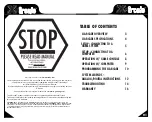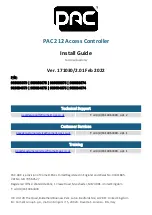
page
40
10 - Using ‘Event Recording’
Studio 12 Scan Control consoles are able to record 12 sequences of events and reproduce them.
In order to do this, a time code is required for sync purposes: for this reason, Studio 12 consoles
are fitted with a socket for connection to an SMPTE signal generator.
This type of signal is used worldwide, mainly in the (television) broadcasting sector. When an
SMPTE signal isn’t available, the console generates a similar signal internally and uses it for sync.
For the complexity of this type of operation, it was decided to only record changes between
memory registers, considering them as ‘events’, and obviously Page changes.
Procedure for event storage records each action at the moment in which it is carried out (for
example enabling a register). Enabling registers in OR, OR and Register and Flash mode requires
the storage of 2 events: one for switching on, the other for switching off.
Overriding registers (AND) on the other hand require just one.
The console’s available memory limit isn’t based on time, but quantity: up to 24.000 events can in
fact be recorded and be run in the course of an entire day. Operators are free to operate manually
on all the console’s sections when events are running.
10.1 - ‘Event Recording’ operating modes
Recorded events can be used (during playback) in two modes: Single Play and Looping Play.
The
button is used to change this mode, in the same way as with Memory registers,
according to the following parameters:
- PLAY button LED off = Single Play
- PLAY button LED on = Looping Play.
In Single Play mode, the selected track is played back from start to finish, whereas in Looping
Play mode, once the last event has been run, the console returns to the beginning for and conti-
nues to run non-stop until terminated by the operator.
Looping Play mode only uses the built-in signal generator: in this case, the SMPTE signal is the-
refore “rejected”.
10.2 - Creating a track
No matter what operating mode they are to be run in, tracks are created using the same criterion.
By pressing and holding down the
buttons for at least 4 seconds, use the memory
register
buttons to select the ‘track’ to be recorded.
During the selection phase, the GRAB and PLAY buttons’ LEDs will be lit, then GRAB will start to
flash and will continue flashing throughout recording. The recording zero (i.e. the beginning) is
given at the moment in which the button of the required track is pressed.
It’s only possible to record crossovers between the various Memory registers (see paragraph 8),
with the relative crossover, flash and page change times.
There’s no way of changing a parameter in the track: if operators make a mistake, they must start
again from the beginning.
smpte
record
g ra b
p l a y
mode
and
or
flash
















































